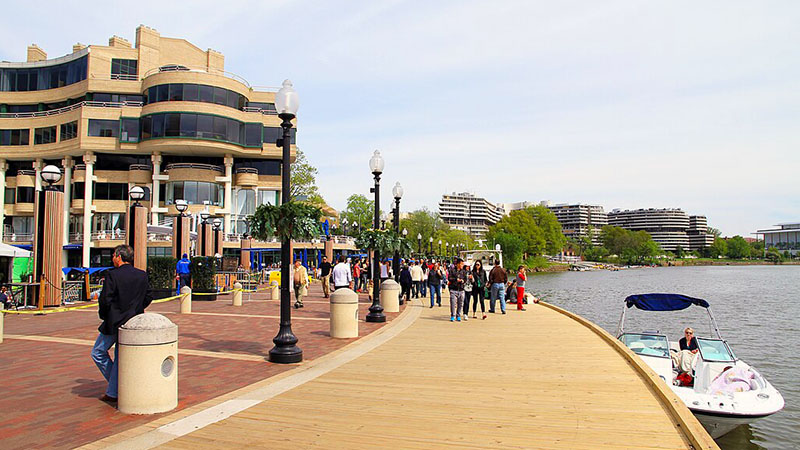The Committee of 100 seeks to have the many waterfront pathways connected along the Potomac River from Georgetown to the Anacostia River and up the Anacostia River to the Maryland line. It is also important to protect the waterfront from overdevelopment, be proactive in addressing flooding, and ensure maximum public access to waterfront areas.
Document Library
- Waterfront Development | Flooding
Waterfront Development | Flooding
C100 Testimony - Anacostia Riverwalk Trail Expansion and National Arboretum Access Bridge
Shelly Repp
Testimony prepared for presentation to the NCPC on February 1, 2024, addressing a proposal for expansion of the Anacostia riverwalk trail and a National Arboretum access bridge, as proposed by the National Park Service in collaboration with DDOT. C100 suggested that the trail expansion can serve as part of a continuous riverfront trail network, which could be branded as the Washington Waterfront Walk.
Proposal On Anacostia Riverwalk Trail Expansion And National Arboretum Access Bridge
Shelly Repp
A Proposal to Consider in Observation of NCPC’s 100th Anniversary in 2024: Related to this, the Committee of 100 encourages the Commission to think more broadly by leading a city-wide effort to designate and support completion of a continuous waterfront trail along the Potomac and Anacostia Rivers from Georgetown to the Maryland line. This could be a signature achievement and a legacy project marking NCPC’s centennial in 2024.
C100 Comments To DC Flood Task Force On Flooding Action Plans
Beth Purcell
The DC Flood Taskforce, sponsored by DOEE and DC Water, identifies policies and projects to bolster flood readiness. In September 2022 the Taskforce released six new action plans for public comment, including Category # 5 - "Flood Infrastructure: to develop a list of capital spending projects to reduce flood risk." C100 filed comments supporting necessary capital spending projects, an action that C100 has advocated for several years.
C100 Planning For Flooding In Washington (Draft)
Beth Purcell, et al.
The District government needs to act now to prevent flooding. The risk of floods in Washington is increasing and threatens the city. The District government should respond now to the threat of 100-year and 500-year floods. We urge the District government to get in front of the problem, adopt the management principle of no adverse impact from flooding, and create a floodplain management plan for all floodplains in the city.
C100 Letter Townsend Tidal Basin Ideas Lab
Kirby Vining
C100 letter to Catherine Townsend, President and CEO of the Trust for the National Mall, dated May 24, 2020, thanking her for her response to the C100 letter to her dated May 12th expressing our concern that the Washington Waterfront Walk concept be included in Trust considerations for the Tidal Basin Ideas Lab.
C100 Letter Townsend Washington Waterfront Walk Concept
Kirby Vining
In its 1997 report, Extending the Legacy, the National Capital Planning Commission called for, "a continuous band of open space [along the District's
riverfronts] from Georgetown to the National Arboretum along the Potomac and Anacostia Rivers".
C100 Flood Plain White Paper
Beth Purcell, et al.
It is critical that the Comprehensive Plan adopt the 500-year floodplain as the basis for climate change planning, and the Generalized Policy Map and the Future Land Use Map must show the 500-year floodplains.
C100 Flood Map 1 Anacostia River
Beth Purcell, et al.
A map of buildings at risk from flooding showing the 100 year zone and the 500 year zone.
C100 Comments Comprehensive Plan For The National Capital Federal Elements - Parks Open Space Element
Stephen A. Hansen
We like the new organizational structure, the key principles, the discussion of designed landscapes, and the categorizations of different types of parks and open space with associated policies. We also applaud the emphasis on protection of the L’Enfant Plan, McMillan Plan, and viewsheds. The discussion is intelligent and thorough and the policies will be helpful as criteria in helping the Commission make recommendations and decisions on proposed projects. We have two major and somewhat related concerns:
1. We are dismayed by the lack of specifics, i.e., any plans or objectives relating to specific park and open space needs or issues.
2. The revised “goal statement” (p. 3) to “protect and enhance the parks and open space system” does not include an important concept in the 2004 Element i.e., “ensure that adequate resources are available for future generations.”

